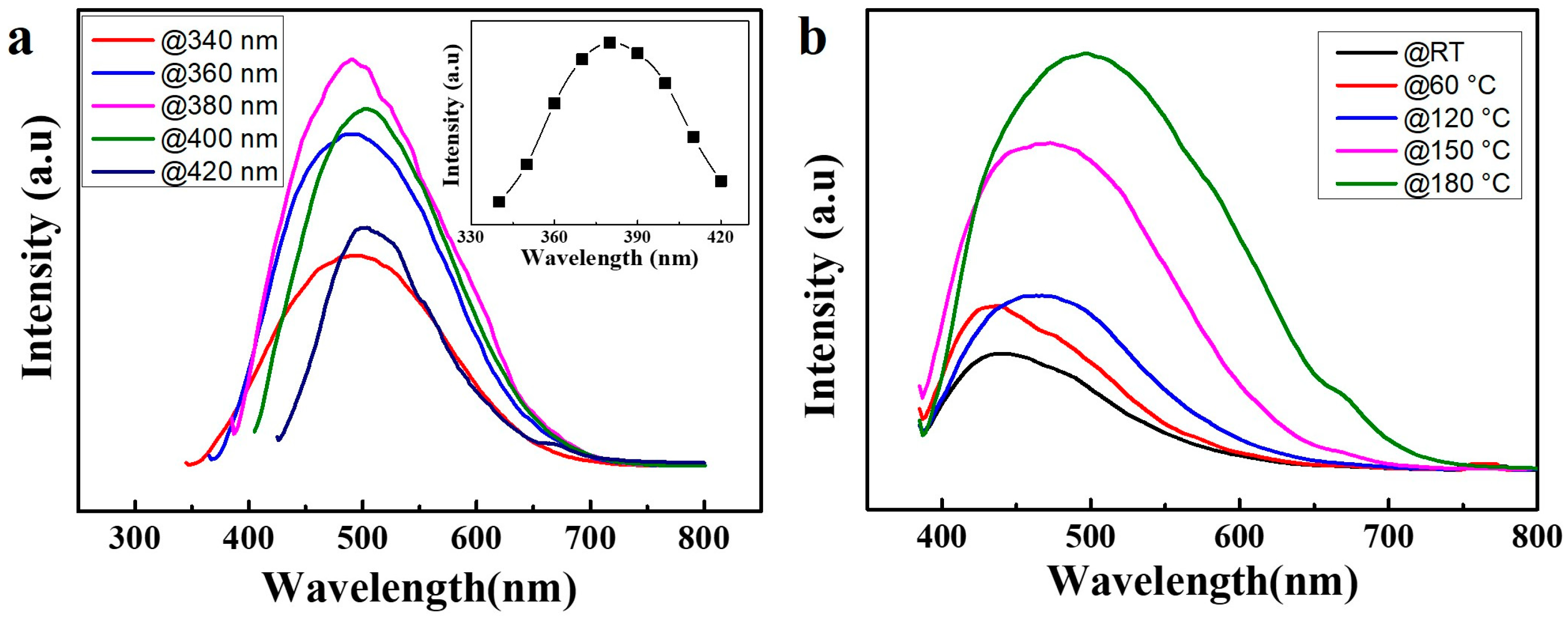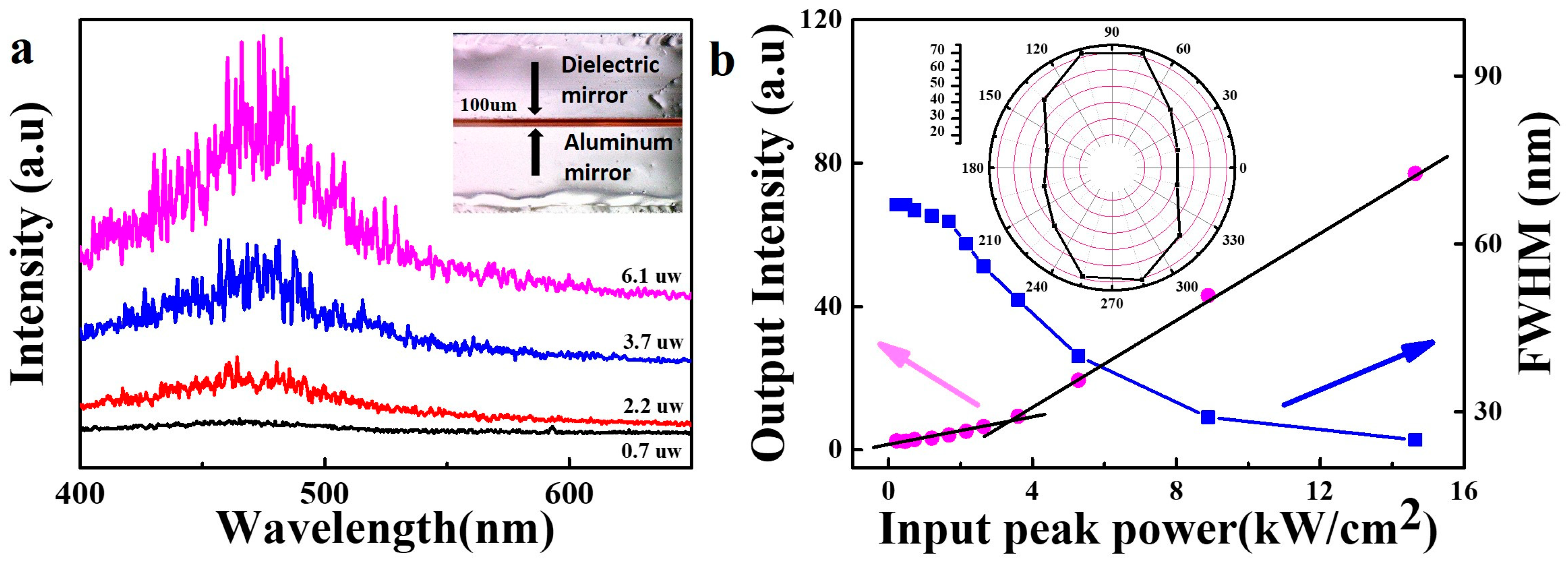Realization of Lasing Emission from One Step Fabricated WSe2 Quantum Dots
Abstract
:1. Introduction
2. Experiment
3. Results and Discussions
4. Conclusions
Author Contributions
Funding
Acknowledgments
Conflicts of Interest
References
- Repp, S.; Erdem, E. Controlling the exciton energy of zinc oxide (ZnO) quantum dots by changing the confinement conditions. Spectrochim. Acta A Mol. Biomol. Spectrosc. 2016, 152, 637–644. [Google Scholar] [CrossRef] [PubMed]
- Repp, S.; Weber, S.; Erdem, E. Defect evolution of nonstoichiometric ZnO quantum dots. J. Phys. Chem. C 2016, 120, 25124–25130. [Google Scholar] [CrossRef]
- Erdem, E. Defect induced p-type conductivity in zinc oxide at high temperature: Electron paramagnetic resonance spectroscopy. Nanoscale 2017, 9, 10983–10986. [Google Scholar] [CrossRef] [PubMed]
- Valappil, M.O.; Anil, A.; Shaijumon, M.; Pillai, V.K.; Alwarappan, S. A single-step electrochemical synthesis of luminescent WS2 quantum dots. Chemistry 2017, 23, 9144–9148. [Google Scholar] [CrossRef] [PubMed]
- Zhao, Y.H.; Yang, F.; Wang, J.; Guo, H.; Ji, W. Continuously tunable electronic structure of transition metal dichalcogenides superlattices. Sci. Rep. 2015, 5, 8356. [Google Scholar] [CrossRef] [PubMed] [Green Version]
- Osada, M.; Sasaki, T. Exfoliated oxide nanosheets: New solution to nanoelectronics. J. Mater. Chem. 2009, 19, 2503. [Google Scholar] [CrossRef]
- Wang, Y.; Ta, V.D.; Gao, Y.; He, T.C.; Chen, R.; Mutlugun, E.; Demir, H.V.; Sun, H.D. Stimulated emission and lasing from CdSe/CdS/ZnS core-multi-shell quantum dots by simultaneous three-photon absorption. Adv. Mater. 2014, 26, 2954–2961. [Google Scholar] [CrossRef] [PubMed] [Green Version]
- Yu, T.; Lim, B.; Xia, Y. Aqueous-phase synthesis of single-crystal ceria nanosheets. Angew. Chem. 2010, 49, 4484–4487. [Google Scholar] [CrossRef] [PubMed]
- Mak, K.F.; Shan, J. Photonics and optoelectronics of 2D semiconductor transition metal dichalcogenides. Nat. Photon. 2016, 10, 216–226. [Google Scholar] [CrossRef]
- Wang, Q.H.; Kalantar-Zadeh, K.; Kis, A.; Coleman, J.N.; Strano, M.S. Electronics and optoelectronics of two-dimensional transition metal dichalcogenides. Nat. Nanotech. 2012, 7, 699–712. [Google Scholar] [CrossRef] [PubMed] [Green Version]
- Bayat, A.; Saievar-Iranizad, E. Synthesis of blue photoluminescent WS2 quantum dots via ultrasonic cavitation. J. Lumin. 2017, 185, 236–240. [Google Scholar] [CrossRef]
- Kapatel, S.; Mania, C.; Sumesh, C.K. Salt assisted sonochemical exfoliation and synthesis of highly stable few-to-monolayer WS2 quantum dots with tunable optical properties. J. Mater. Sci.-Mater. Electron. 2017, 28, 7184–7189. [Google Scholar] [CrossRef]
- Long, H.; Tao, L.; Chiu, C.P.; Tang, C.Y.; Fung, K.H.; Chai, Y.; Tsang, Y.H. The WS2 quantum dot: Preparation, characterization and its optical limiting effect in polymethylmethacrylate. Nanotechnology 2016, 27, 414005. [Google Scholar] [CrossRef] [PubMed]
- Yan, Y.; Zhang, C.; Gu, W.; Ding, C.; Li, X.; Xian, Y. Facile synthesis of water-soluble WS2 quantum dots for turn-on fluorescent measurement of lipoic acid. J. Phys. Chem. C 2016, 120, 12170–12177. [Google Scholar] [CrossRef]
- Ghorai, A.; Bayan, S.; Gogurla, N.; Midya, A.; Ray, S.K. Highly luminescent WS2 quantum dots/ZnO heterojunctions for light emitting devices. ACS Appl. Mater. Interfaces 2017, 9, 558–565. [Google Scholar] [CrossRef] [PubMed]
- Xu, S.; Li, D.; Wu, P. One-pot, facile, and versatile synthesis of monolayer MoS2/WS2 quantum dots as bioimaging probes and efficient electrocatalysts for hydrogen evolution reaction. Adv. Funct. Mater. 2015, 25, 1127–1136. [Google Scholar] [CrossRef]
- Zhao, X.; Ma, X.; Sun, J.; Li, D.; Yang, X. Enhanced catalytic activities of surfactant-assisted exfoliated WS(2) nnanodots for hydrogen evolution. ACS Nano 2016, 10, 2159–2166. [Google Scholar] [CrossRef] [PubMed]
- Zhou, L.; Yan, S.; Wu, H.; Song, H.; Shi, Y. Facile sonication synthesis of WS2 quantum dots for photoelectrochemical performance. Catalysts 2017, 7, 18. [Google Scholar] [CrossRef]
- Tonndorf, P.; Schmidt, R.; Böttger, P.; Zhang, X.; Börner, J.; Liebig, A.; Albrecht, M.; Kloc, C.; Gordan, O.; Zahn, D.R.T.; et al. Photoluminescence emission and raman response of monolayer MoS2, MoSe2, and WSe2. Opt. Express 2013, 21, 4908–4916. [Google Scholar] [CrossRef] [PubMed]
- Park, J.; Lee, W.; Choi, T.; Hwang, S.H.; Myoung, J.M.; Jung, J.H.; Kim, S.H.; Kim, H. Layer-modulated synthesis of uniform tungsten disulfide nanosheet using gas-phase precursors. Nanoscale 2015, 7, 1308–1313. [Google Scholar] [CrossRef] [PubMed]
- Song, Q.; Liu, L.; Xiao, S.; Zhou, X.; Wang, W.; Xu, L. Unidirectional high intensity narrow-linewidth lasing from a planar random microcavity laser. Phys. Rev. Lett. 2006, 96, 033902. [Google Scholar] [CrossRef] [PubMed]
- Ouyang, Q.; Zeng, S.; Jiang, L.; Hong, L.; Xu, G.; Dinh, X.Q.; Qian, J.; He, S.; Qu, J.; Coquet, P.; et al. Sensitivity enhancement of transition metal dichalcogenides/silicon nanostructure-based surface plasmon resonance biosensor. Sci. Rep. 2016, 6, 28190. [Google Scholar] [CrossRef] [PubMed]
- Splendiani, A.; Sun, L.; Zhang, Y.; Li, T.; Kim, J.; Chim, C.Y.; Galli, G.; Wang, F. Emerging photoluminescence in monolayer MoS2. Nano Lett. 2010, 10, 1271–1275. [Google Scholar] [CrossRef] [PubMed]
- Tongay, S.; Zhou, J.; Ataca, C.; Lo, K.; Matthews, T.S.; Li, J.; Grossman, J.C.; Wu, J. Thermally driven crossover from indirect toward direct bandgap in 2D semiconductors: MoSe2 versus MoS2. Nano Lett. 2012, 12, 5576–5580. [Google Scholar] [CrossRef] [PubMed]
- Bai, G.; Yuan, S.; Zhao, Y.; Yang, Z.; Choi, S.Y.; Chai, Y.; Yu, S.F.; Lau, S.P.; Hao, J. 2D layered materials of rare-earth er-doped MoS2 with NIR-to-NIR down- and up-conversion photoluminescence. Adv. Mater. 2016, 28, 7472–7477. [Google Scholar] [CrossRef] [PubMed]
- Lee, Y.C.; Tseng, Y.C.; Chen, H.L. Single type of nanocavity structure enhances light outcouplings from various two-dimensional materials by over 100-fold. ACS Photon. 2016, 4, 93–105. [Google Scholar] [CrossRef]
- Bai, X.; Wang, J.; Mu, X.; Yang, J.; Liu, H.; Xu, F.; Jing, Y.; Liu, L.; Xue, X.; Dai, H.; et al. Ultrasmall WS2 quantum dots with visible fluorescence for protection of cells and animal models from radiation-induced damages. ACS Biomater. Sci. Eng. 2017, 3, 460–470. [Google Scholar] [CrossRef]
- Lu, X.; Wang, R.; Hao, L.; Yang, F.; Jiao, W.; Peng, P.; Yuan, F.; Liu, W. Oxidative etching of MoS2/WS2 nanosheets to their QDs by facile UV irradiation. Phys. Chem. Chem. Phys. 2016, 18, 31211–31216. [Google Scholar] [CrossRef] [PubMed]
- Tang, X.; Hu, Z.; Chen, W.; Xing, X.; Zang, Z.; Hu, W.; Qiu, J.; Du, J.; Leng, Y.; Jiang, X.; et al. Room temperature single-photon emission and lasing for all-inorganic colloidal perovskite quantum dots. Nano Energy 2016, 28, 462–468. [Google Scholar] [CrossRef]
- Wang, Y.; Li, X.; Song, J.; Xiao, L.; Zeng, H.; Sun, H. All-Inorganic colloidal perovskite quantum dots: A new class of lasing materials with favorable characteristics. Adv. Mater. 2015, 27, 7101–7108. [Google Scholar] [CrossRef] [PubMed]
- Zhang, W.F.; Zhu, H.; Yu, S.F.; Yang, H.Y. Observation of lasing emission from carbon nanodots in organic solvents. Adv. Mater. 2012, 24, 2263–2267. [Google Scholar] [CrossRef] [PubMed]
- Qu, S.; Liu, X.; Guo, X.; Chu, M.; Zhang, L.; Shen, D. Amplified spontaneous green emission and lasing emission from carbon nanoparticles. Adv. Funct. Mater. 2014, 24, 2689–2695. [Google Scholar] [CrossRef]
- Zhang, X.; Lai, Z.; Liu, Z.; Tan, C.; Huang, Y.; Li, B.; Zhao, M.; Xie, L.; Huang, W.; Zhang, H. A facile and universal top-down method for preparation of monodisperse transition-metal dichalcogenide nanodots. Angew. Chem. 2015, 54, 5425–5428. [Google Scholar] [CrossRef] [PubMed]
- Li, H.; Wu, J.; Yin, Z.; Zhang, H. Preparation and applications of mechanically exfoliated single-layer and multilayer MoS(2) and WSe(2) nanosheets. Acc. Chem. Res. 2014, 47, 1067–1075. [Google Scholar] [CrossRef] [PubMed]
- Karfa, P.; Madhuri, R.; Sharma, P.K. Multifunctional fluor escent chalcogenide hybrid nanodots (MoSe2:CdS and WSe2:CdS) as electro catalyst (for oxygen reduction/oxygen evolution reactions) and sensing probe for lead. J. Mater. Chem. A 2017, 5, 1495–1508. [Google Scholar] [CrossRef]
- Hernandez, Y.; Nicolosi, V.; Lotya, M.; Blighe, F.M.; Sun, Z.; De, S.; McGovern, I.T.; Holland, B.; Byrne, M.; Gun’ko, Y.K.; et al. High-yield production of graphene by liquid-phase exfoliation of graphite. Nat. Nanotech. 2008, 3, 563–568. [Google Scholar] [CrossRef] [PubMed] [Green Version]




© 2018 by the authors. Licensee MDPI, Basel, Switzerland. This article is an open access article distributed under the terms and conditions of the Creative Commons Attribution (CC BY) license (http://creativecommons.org/licenses/by/4.0/).
Share and Cite
Ren, P.; Zhang, W.; Ni, Y.; Xiao, D.; Wan, H.; Peng, Y.-P.; Li, L.; Yan, P.; Ruan, S. Realization of Lasing Emission from One Step Fabricated WSe2 Quantum Dots. Nanomaterials 2018, 8, 538. https://doi.org/10.3390/nano8070538
Ren P, Zhang W, Ni Y, Xiao D, Wan H, Peng Y-P, Li L, Yan P, Ruan S. Realization of Lasing Emission from One Step Fabricated WSe2 Quantum Dots. Nanomaterials. 2018; 8(7):538. https://doi.org/10.3390/nano8070538
Chicago/Turabian StyleRen, Pengpeng, Wenfei Zhang, Yiqun Ni, Di Xiao, Honghao Wan, Ya-Pei Peng, Ling Li, Peiguang Yan, and Shuangchen Ruan. 2018. "Realization of Lasing Emission from One Step Fabricated WSe2 Quantum Dots" Nanomaterials 8, no. 7: 538. https://doi.org/10.3390/nano8070538




